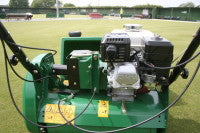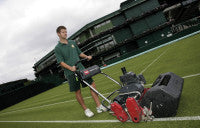Stress busting
 Mowing is the most widely used maintenance operation in the preparation of grass surfaces for sports use. It is generally regarded as the most influential treatment affecting both the playing quality of the surface and plant health. However, although being an essential process that prepares playing surfaces for users, one must not forget that, at the same time, it can damage the grass which, in turn, can result in the turf being vulnerable to other stresses.
Mowing is the most widely used maintenance operation in the preparation of grass surfaces for sports use. It is generally regarded as the most influential treatment affecting both the playing quality of the surface and plant health. However, although being an essential process that prepares playing surfaces for users, one must not forget that, at the same time, it can damage the grass which, in turn, can result in the turf being vulnerable to other stresses.
Mowing often results in the significant removal of a large proportion of leaf tissue that would otherwise be used by plants to convert solar energy into chemical energy. Mowing reduces the rate of photosynthesis and, in doing so, reduces the ability of the plant to produce carbohydrates which are necessary for growth and survival.
The challenge for the turf manager, therefore, is to balance playability with turf health. This article aims to look at some aspects of mowing that help the turf manager favour the health of the turf, particularly at the lower end of the mowing tolerance range for grasses.
Plant physiology
It is well documented, but worth repeating, that the changes occur as a result of varying heights of cut and increasing mowing frequency that is invariably necessary for preparing playing surfaces. As the mowing height is adjusted to the optimum for each turfgrass species, in general the following changes can occur:
• Carbohydrate synthesis and storage are reduced
• Leaf width and root growth are reduced
• Shoot density is increased
• Shoot growth is increased
• Chlorophyll content is increased
• Tissue succulence is increased
As the mowing frequency is increased, further changes occur:
• Carbohydrate storage reserves are reduced
• Root, rhizome and stolon development are reduced
• Leaf width and elongation rate are reduced
• Shoot density is increased
• Tissue succulence is increased
Mower type/configurations
 Careful selection and manipulation of mowing height and frequency are very important considerations for the turf manager. Recognition of the mowing tolerances of grass species, the use to which the turf is put, as well as environmental stresses need serious consideration.
Careful selection and manipulation of mowing height and frequency are very important considerations for the turf manager. Recognition of the mowing tolerances of grass species, the use to which the turf is put, as well as environmental stresses need serious consideration.
Currently, in putting green situations, the role of mower type and roller configuration has taken on great importance, especially in the US. At the better US golf courses, greens mower configurations are applied to match the circumstances. Mowers are invariably pedestrian, reel type cylinder mowers at such courses. The configurations range from fixed head pedestrian mowers with grooved front rollers, to pedestrian mowers of floating or flex reel arrangements with solid front rollers.
If turf is growing vigorously, then the more aggressive mower combination of fixed head and grooved front roller are often chosen. Early research findings by Rossi & Thurn (2004) indicated and supported the notion that all pedestrian cylinder mowers are not alike in their effect on turf quality and anthracnose disease occurrence at the same height of cut. Somewhat controversially perhaps, it was noted that there was significant difference between fixed head mowing units.
Whilst some of the better resourced UK and Irish courses may use pedestrian mowers on their greens, there is normally less variation of set-up to suit circumstances.
Good quality fairway type turf can be produced with ride-on 5 unit mowers, but, even here, there are options for mower configuration.
Mower set-up
Further Rossi & Thurn work indicated that the positioning of the bedknives relative to the reel influenced the aggressiveness of cut. The distance of the front roller from the cutting unit as determined by groomer design, also seems to have an influence on scalping. Howieson & Christian's (2001) examination of mower settings emphasises the importance of appropriate reel to bedknife adjustment. Least injury (shredding and browning), highest visual quality and chlorophyll content was found from the mower maintained with slight reel to bedknife contact for the duration of the trial. The poorest results were found from the mower that was left with slightly "dull" setup and without any contact between bedknife and reel. 
Rossi & Thurn observed that fixed head units came out of adjustment sooner than flex or floating units. Carson (2007) also suggests that bedknife thickness influences turf quality. He found that thick bedknives produced the lowest turf colour ratings, although the research was deemed non-conclusive.
Quite recent research, by the STRI for Bernhards & Co. Ltd., has confirmed the importance of sharp, correctly set-up mowing equipment, not only in terms of quality of cut and presentation, but also reducing the stress on turf and decreasing the risk of disease incidence etc.
De-stressing the turf
Under environmentally induced stress situations of heat, disease or shade, adjustment of mowing practice to turf surfaces that may already be below optimum cutting height range, becomes crucial. It is one of the first means of alleviating the stress and promotion of recovery.
Typically adjustments to stressed, short cut turf involve the following:
• Postpone mowing for a number of days to arrest decline and until turf health improves. Resume mowing at a higher height
• Raise the mowing height. Simple adjustment of mowing height upwards by 0.38mm from 3.2mm to 3.6mm alleviated anthracnose disease significantly. The shorter the mowing height, the less leaf area that remains to gather light and perform photosynthesis
• Delay mowing until surfaces are free of surface water. Scalping is possible if mowers sink into soft, wet turf
• Skip mowing once or twice per week. In doing so, frequency of cut shall be mindful of the one third rule, which removes no more than one third vertical growth per cut
• Stop double cutting. Whilst recent research into anthracnose disease management would suggest double cutting to maintain ball speed, at a higher height of cut, significantly reduced this disease stress, earlier findings suggest avoiding this practice
• Maintain well adjusted mowers to reduce wounding. Wounds offer a further entry point for disease and reduce the leaf chlorophyll content
• Deploy the lightest pedestrian mowers possible
• Use pedestrian mowers instead of triplex mowers. Whilst there is no hard research evidence to support the difference upon turf quality of the two types of mower, the lighter option should reduce tissue damage. The action of triplex mowers on perimeters can be quite damaging and is sufficient reason to mow with pedestrian cylinder mowers
• Empty grass collectors before mowing each green and each perimeter to reduce downward force
• Reduce mowing frequency to perimeters
• Reduce mowing speed to perimeters
• Stop verticutting (and possibly grooming). Whilst not mowing in the truest sense, verticutting is a form of defoliation. Recent research into cultural influences upon anthracnose disease occurrence indicates that, once verticutting is limited to the leaf and not the crown, there is no negative effect on disease incidence. In a stressed environment, however, it would seem sensible to stop verticutting altogether to maximise leaf area
The adjustment practices above have largely been driven, in the last decade or so, by research into anthracnose disease control to putting surfaces.
 Stressing turf through mowing practices has been observed at potentially harsh coastal golf course environments, noted for their slower growing conditions. The reduction in mechanical stress, especially through mowing, has found particular favour in the gradual promotion of fescue in such environments.
Stressing turf through mowing practices has been observed at potentially harsh coastal golf course environments, noted for their slower growing conditions. The reduction in mechanical stress, especially through mowing, has found particular favour in the gradual promotion of fescue in such environments.
In situations other than fine turf surfaces, the value of replacing grooved or spiral front rollers with solid front rollers has been notable on the perimeters of tees and fairways, where mowing of non-straight lines may otherwise see stressed turf.
In difficult sports environments, the effect of the mower in relieving turf stress is also recognised. Who would ever have envisaged in recent years the incorporation of lightweight pedestrian rotary mowers within the mowing regime? Such mowers have come to dominate general mowing practice at some sites in the UK and Ireland. They have the added advantage of ensuring a more upright plant and removal of thatch forming debris. Importantly, they offer a lighter weight option to heavier cylinder mowers where the potential to surface smear is greater.
Adjustment of the mowing practice can overcome a sometimes disastrous situation, and allow better sleep at night!
